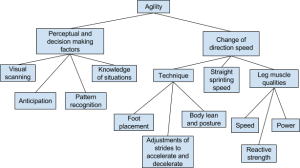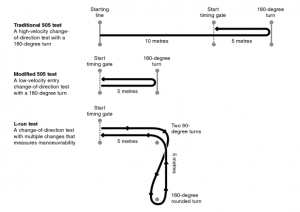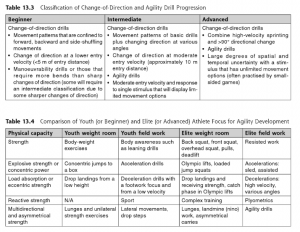Definitions
“The ability to change direction and start and stop quickly” (Gambetta, 1996)
“A rapid whole body movement with change of velocity or direction in response to a stimulus” (Sheppard and Young 2006)
Types of Movements
Initiation Movements
In an initiation movement, the athlete aims to either initiate or change movement. These will normally involve a short, rapid movement that allows athletes to either start or change their movement patterns. For example, a soccer player waiting for a corner may initiate movement with a cross-step in an attempt to lose the defender and get his or her head to the ball. Similarly, if this is not successful, the player may change the direction of his or her run via a cut step. In both cases, these would be initiation moves. Typical initiation movements include cross-steps, first-step starts, dropsteps and cut steps.
Transition Movements
In a transition movement, the athletes’ main concern is keeping themselves in a position in which they will be able to read, and react to, a stimulus. The aim of the movement is not always to move at maximal speeds, but instead the movement focuses on body position, maintaining the optimum position for rapid reaction.
In most sports, movements such as sideshuffles, backpedals, and chop steps are more often than not transition movements, and rarely are these movements performed for a long distance. For example, if the aim of the athlete is to get to a point behind them as quickly as possible, the athletes will normally drop step and sprint rather than backpedaling for the given distance.
A backpedal is predominantly used as a transition movement, while the athlete waits for the appropriate stimulus to react to, such as a cornerback waiting for the receiver to make a move.
Actualization Movements
An actualization movement is normally the movement that ultimately decides the success of the sequence, and will normally involve either a sport skill or a sprint to a given position. At this point, the athlete will have responded to a stimulus and will aim either to get to a point as effectively as possible or to carry out a sport skill.
Agility Classifications
- Simple – No uncertainty e.g. gymnasts floor routine
- Temporal – Temporal uncertainty, movement is still planned e.g. athletes sprint start
- Spatial – Spatial uncertainty, but timing of movement is preplanned e.g. tennis serve
- Universal – Spatial and temporal uncertainty e.g. football offensive and defensive moves
(Sheppard and Young 2006)
Deterministic model of agility
Factors that influence agility demands
- Sprint distances and directions
- Acceleration, deceleration, change of direction (COD) at maximal speed
- Footwork patterns
- COD, stopping, turning
- Pitch or court dimensions
- Positional demands and on and off the ball demand
Sample classifications of CODS and agility tests (Nimphius in Joyce/Lewindon, 2014)
| Change-of-direction speed (CODS) tests | Manoeuvrability | Reactive agility test (RAT |
| Traditional 5-0-5 (high vel CODS)
Modified 5-0-5 (low vel CODS) Pro-agility (low & high vel CODS) 10m shuttle (mod to high vel CODS) |
T-test
Illinois agility test L-run AFL agility test Three-cone agility test |
RAT in response to an arrow or light
RAT in response to a video RAT in response to a human stimulus |
Comparison of CODS test (Nimphius in Joyce/Lewindon, 2014)
Progressions (Nimphius)
Coaching points and exercises
Externally focussed cues have been shown to be more effective than internally focussed ones (Porter et al, 2010)
| Foot Placement | As well as anterior-posterior ground reaction forces, the foot and lower limb has to deal with medial-lateral forces |
| Weight Distribution | Point to the belly button and reinforce balance |
| Posture | Use leaning drills to explore the limits of an athlete’s balance |
| Body Alignment | Utilising body mass and trunk rotation for forward speed and CoD |
| Limb Action | Using the arms to help drive for speed and leg strength to power off for CoD |
| Movement Path or Distance | Depending on if stimulus is used and whether the movement is preplanned |
| Force Application | “push the ground away from you”
“force the triple extension” “finish your drive” “catch and push through the floor” |


